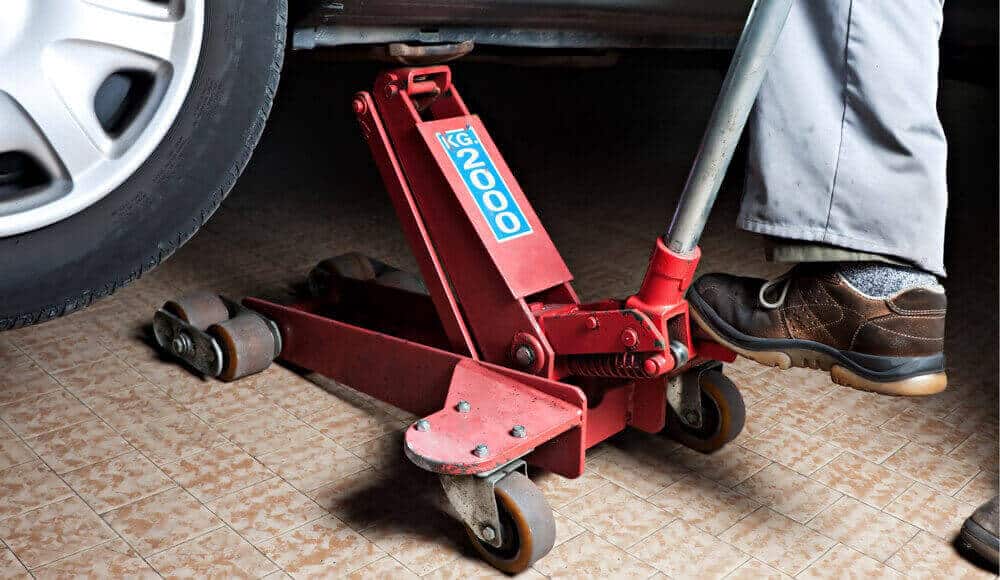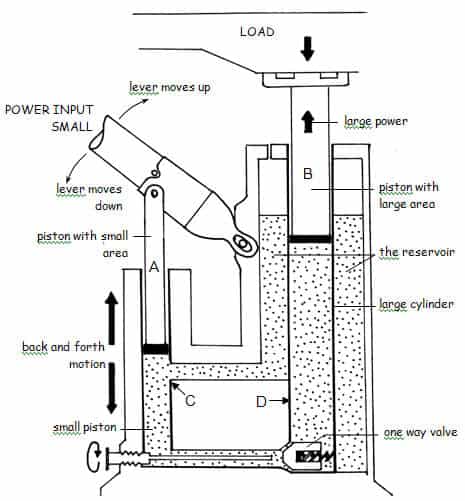April 15, 2022

I read through a forum the other day, and one question that kept popping up in that forum was all about hydraulic jack and how it works. Of course, the hydraulic jack is often utilized in most shop works instead of being used for emergency purposes. It is also used sometimes to lift elevators in medium and low-rise buildings.
What makes the hydraulic jack unique is that it makes use of a liquid that is incompressible. Oil is the usual liquid used in a hydraulic jack because it is stable and self-lubricating. This liquid is then forced into a cylinder via the plunger that pumps. When the plunger makes a pull-back motion, it will draw oil then out of the cylinder via the check valve onto the chamber of the pump (pump chamber).
As the plunger makes a forward plunge, it then pushes the liquid along a discharge check valve onto a cylinder. With every movement of the plunger, the ball of the discharge valve external to the chamber opens. Then, the oil rushes onto the cylinder. Afterward, the ball forces the chamber to shut as the cylinder’s liquid pressure builds up.
The Principle Behind a Hydraulic Jack
Hydraulic jacks make use of Hydraulics, a technology used in engineering, chemistry, and other aspects of life. It uses liquid, and it is the liquid counterpart of the pneumatics science, which deals with gases. Moreover, the hydraulic cylinder, like the one used in hydraulic pumps, works according to Pascal’s Principle.
First, it requires an incompressible liquid inside the cylinder. With the use of incompressible fluid, the cylinder’s pressure remains the same anywhere in the cylinder. Thus, if you connect a larger cylinder to the smaller cylinder just like in a hydraulic jack and apply a force to the smaller cylinder, the larger cylinder’s pressure remains the same with that of the smaller cylinder.
Despite having the same pressure in both cylinders, the larger cylinder’s force output is greater given its larger piston area. The Pascal Law (Force= Pressure x Area) summarizes this phenomenon. This principle is the same principle applied in an engine hoist.
How Does Hydraulic Jacks Work?

The good thing about the hydraulic jack is that it produces greater force at a minimal initial force. The dynamism behind a hydraulic jack’s workings may be hard to fathom for those who are not scientifically inclined. Yet, it is pretty straightforward!
When utilizing a hydraulic jack, you need to position the load (to be lifted) on a leveled surface. If you want to raise a car, you need to set your vehicle on a leveled ground.
Then, when everything is in place, you use the jack handle, applying a bit of force. The resultant force on the other end of the jack is greater than the applied pressure on the jack handle.
The hydraulic jack then produces pressure by moving the liquid (oil) through two cylinders through a pump plunger. When you draw back the pump plunger, the suction valve opens and draws out fluid from the pump chamber’s oil reservoir.
Then, as you push down the plunger, the oil moves via the external discharge valve onto the cylinder chamber. The valve (suction) closes then. This closing of the valve results in the buildup of pressure within the chamber.
The piston in the chamber rises and lifts whatever load you would like to raise. You can repeat this process many times, letting you lift the vehicle to a higher position.
What Fluid Does the Hydraulic Jack Use?
Since the hydraulic jack makes use of Pascal’s Principle and utilizes incompressible liquid (meaning you can never compress the liquid), then the choice of liquid in the hydraulic jack requires certain specific properties.
The fluid should have perfect viscosity, thermal stability, hydrolytic stability, filterability, and many other essential characteristics. If the jack uses the right liquid, then the maximum performance, smooth operation, and self-lubrication are achieved.
Engineers have designed the hydraulic jacks in such a way that you can apply minimal initial force and produce greater resultant force.
Are the Cylinders Fully Filled?
If you look inside a hydraulic jack and inspect the cylinders, you will notice that the cylinders are not filled with liquid, but partially filled. This partial amount of liquid allows you to apply pressure on the smaller cylinder. This pressure will then equally transmit to the larger cylinder with the help of the incompressible fluid.
This transmission of pressure will experience a multiplication of the effects of this force. However, the pressure exerted on all parts of both cylinders will be the same. Nevertheless, the larger cylinder’s force will be higher than that of the small cylinder because of its larger surface area.
The Pumping System
Aside from the cylinders, valves, and handle, the hydraulic jack also contains a pumping system. This pumping system pushes the fluid into the cylinder via a one-way valve. This valve restricts the backflow of the liquid from the cylinder back to the pump plunger.
The pumping system comes with a pump cylinder, a handle, and a handle socket. The pumping system comes with a pump cylinder, a handle, and a handle socket. The handle goes though the handle socket. Then, using hand power, you can apply pressure onto the cylinder.
The pumping system also comes with small rings, links, pins, and steel balls to cover the washers and the pump cylinder. The hydraulic jack may look simplistic. Yet, it can raise or lift heavy materials using relatively small force.
How to Use the Hydraulic Jack?
As mentioned above, before using the hydraulic jack, you should look for a leveled ground to position the load that you want to lift. For example, park the car on a leveled surface for your safety and ease of work. Check the user manuals of the hydraulic jack and know the safety precautions when raising a car off the ground.
Once the car is on a leveled ground, check the car’s weight and figure out if the hydraulic jack can lift it according to the manuals’ specifications.
Then, set the brakes of the car. Ensure that the car is on its brakes to prevent rolling or moving when you lift it using the hydraulic jack. Use wheel chocks on the back and front side of the car to prevent the wheel from moving.
Then, look for the pinch metal to clip. You can see this squeeze metal underneath the car’s body. Clip the jack for lifting. Take note that different cars have various positioned pinch metals. Survey the place where to clip before inserting the jack.
Then, make sure that the jack handle is in a released position. Gently slide the jack handle underneath the car’s body to start lifting the vehicle. You will need a bit of force when you begin to lift the vehicle to the appropriate position.
Then, support your vehicle with a jack stand underneath as you remove the hydraulic floor jack. Start by slowly releasing the jack handle to loosen it up before you remove the hydraulic floor jack. Once done with the task, then use the hydraulic jack to lift the car again so that you can have ample space to remove the jack stand. Then, you can remove the jack stand and lower the car using the hydraulic jack.
Safety Tips When Using Hydraulic Jacks
Joseph Curtis invented the hydraulic jack in the 1830s. Since then, the hydraulic jacks have evolved, and now you can find different brands and models of hydraulic jacks. However, if you use a hydraulic jack in your garage or any business workplace, you should consider the following safety precautions:
- Check the load capacity of the jack.
- Don’t crawl or walk under a hydraulic jack.
- Change its oil regularly.
- Wear safety clothes like PPE when working using the hydraulic jack.
- Lift the load using the appropriate jack points.
Conclusion
The most apparent advantages of using hydraulic jacks include faster speed, higher capacity, and greater mobility with its casters. However, the downsides of using it include its large size, heavyweight, and hydraulic fluid maintenance. So, if you want to have a faster jack that you can always use, then it will help if you opt for the hydraulic jack.
However, finding the right hydraulic jack may prove challenging, given the myriad of brands and models of hydraulic jacks today. Yet, if you know the abovementioned factors to consider and the most recommended hydraulic jacks, the search process will become easy for you.
